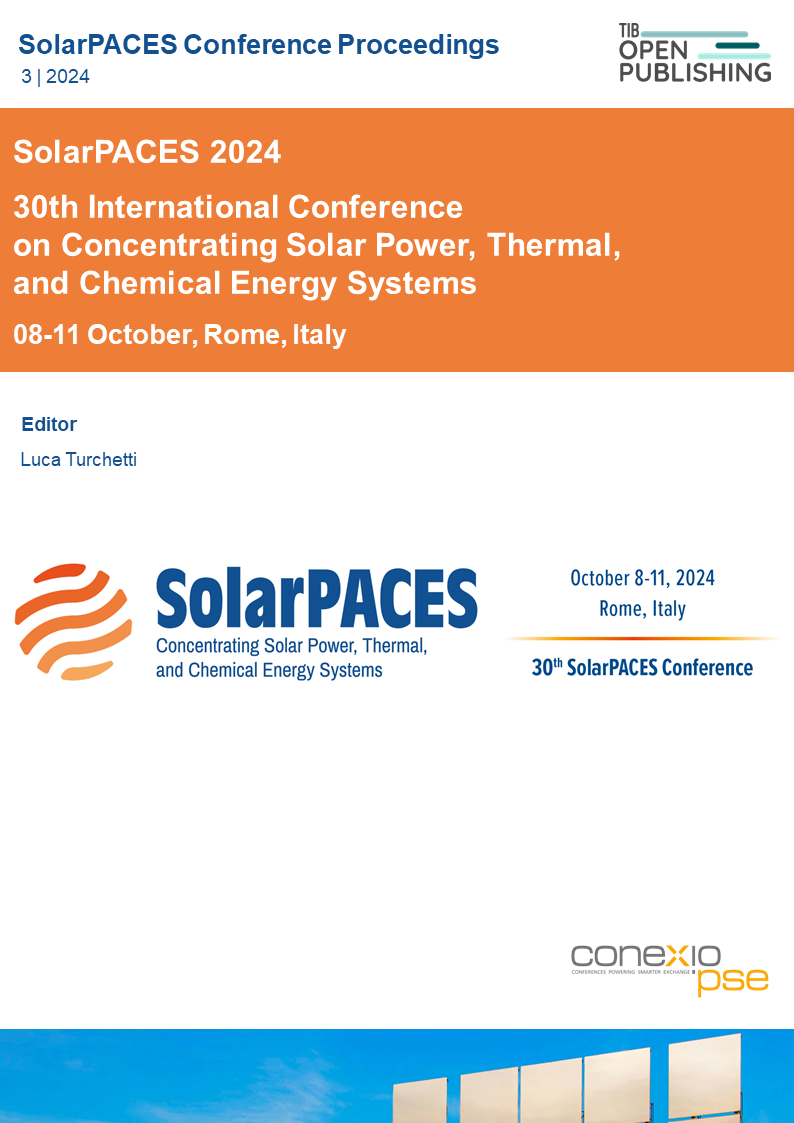NEWS4CSP Project – New Coatings Approaches to Protect Metallic Materials From Heat Transfer Fluids
DOI:
https://doi.org/10.52825/solarpaces.v3i.2321Keywords:
Corrosion, Metallic Coatings, Laser Cladding, Molten SaltsAbstract
The efficiency of Concentrated Solar Power technologies increases with the operation temperature of the power block, which can be achieved using advanced power cycles operating at temperatures ≥650°C. Molten Salt (MS) based HTF have been facing critical challenging issues of severe corrosion and lower specific heat capacity. This paper aims to present the NEWS4CSP project to the CSP scientific community, highlighting the main concepts being pursued and the preliminary results obtained regarding the application of new coatings to increase the anticorrosive protection of structural materials in contact with MS. Two different types of powder coatings (nickel and cobalt alloys) were applied to AISI 430 stainless steel using two coating technologies: High Velocity Oxy-Fuel (HVOF) and Laser Cladding (LC). LC proved to be the most suitable technique of these two coating application technologies. The Co-Cr coating alloy showed good anticorrosive behaviour even after 3000 h of testing. The obtained results are very promising, nevertheless, more studies are needed to optimise its application by LC. These include optimizing the thickness and chemical composition, as well as gaining a deeper understanding of the degradation mechanisms and whether this behaviour is maintained over longer periods.
Downloads
References
[1] C. Prieto, S. Fereres, F. J. Ruiz-Cabañas, A. Rodriguez-Sanchez, and C. Montero, ‘Carbonate molten salt solar thermal pilot facility: Plant design, commissioning and operation up to 700 °C’, Renewable Energy, vol. 151, pp. 528–541, May 2020, doi: 10.1016/j.renene.2019.11.045.
[2] W. Ding et al., ‘Molten chloride salts for next generation concentrated solar power plants: Mitigation strategies against corrosion of structural materials’, Solar Energy Materials and Solar Cells, vol. 193, pp. 298–313, May 2019, doi: 10.1016/j.solmat.2018.12.020.
[3] H. Ai et al., ‘Metallic impurities induced corrosion of a Ni-26W-6Cr alloy in molten fluoride salts at 850 oC’, Corrosion Science, vol. 178, p. 109079, Jan. 2021, doi: 10.1016/j.corsci.2020.109079.
[4] V. M. B. Nunes, M. J. V. Lourenço, F. J. V. Santos, and C. A. Nieto de Castro, ‘Molten alkali carbonates as alternative engineering fluids for high temperature applications’, Applied Energy, vol. 242, pp. 1626–1633, May 2019, doi: 10.1016/j.apenergy.2019.03.190.
[5] A. Ibrahim, H. Peng, A. Riaz, M. Abdul Basit, U. Rashid, and A. Basit, ‘Molten salts in the light of corrosion mitigation strategies and embedded with nanoparticles to enhance the thermophysical properties for CSP plants’, Solar Energy Materials and Solar Cells, vol. 219, p. 110768, Jan. 2021, doi: 10.1016/j.solmat.2020.110768.
[6] V. Encinas-Sánchez, E. Batuecas, A. Macías-García, C. Mayo, R. Díaz, and F. J. Pérez, ‘Corrosion resistance of protective coatings against molten nitrate salts for thermal energy storage and their environmental impact in CSP technology’, Solar Energy, vol. 176, pp. 688–697, Dec. 2018, doi: 10.1016/j.solener.2018.10.083.
[7] S. S. Raiman, R. T. Mayes, J. M. Kurley, R. Parrish, and E. Vogli, ‘Amorphous and partially-amorphous metal coatings for corrosion resistance in molten chloride salt’, Solar Energy Materials and Solar Cells, vol. 201, p. 110028, Oct. 2019, doi: 10.1016/j.solmat.2019.110028.
Published
How to Cite
Conference Proceedings Volume
Section
License
Copyright (c) 2025 Teresa C. Diamantino, Fátima Pedrosa, Teresa Paiva, Eduardo Silva, Francisco Gonçalves, Renato Monteiro, João P. Cardoso

This work is licensed under a Creative Commons Attribution 4.0 International License.
Accepted 2025-03-28
Published 2025-11-18
Funding data
-
Fundação para a Ciência e a Tecnologia
Grant numbers 2022.05021.PTDC;https://doi.org/10.54499/2022.05021.PTDC
